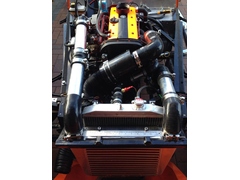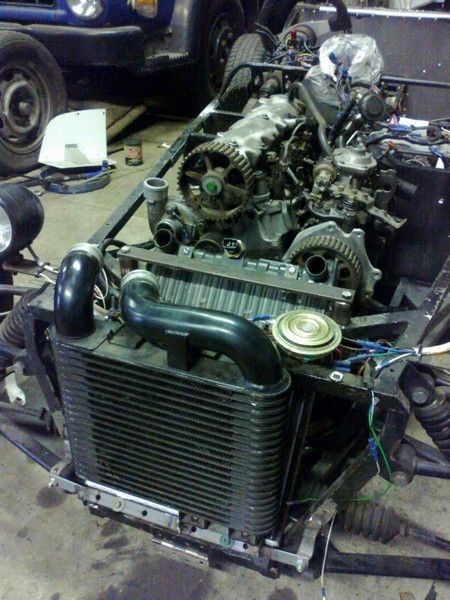tajgreidotu
|
| posted on 15/11/15 at 09:05 PM |

|
|
Polo rad - vertical?
Hi all,
Im sure there should be a reason but, is it possible to use the polo rad in vertical instead of horizontal?
Just checked and fits perfectly under the nose cone!
To good to be true?

|
|
|
|
|
gremlin1234
|
| posted on 15/11/15 at 09:21 PM |

|
|
rads always used to be fitted with tanks at top and bottom, so should be no problem there.
ref: http://www.canleyclassics.com/heating-and-cooling/spitfire-full-width-radiator/
however,
1: it will leave the thermostatic switch as the highest point and no easy way to bleed it.
2: feeding and returning coolant at the top will cause issues.
|
|
|
craig1410
|
| posted on 15/11/15 at 11:22 PM |

|
|
I would recommend against this as you will be fighting against the natural thermo-syphon effect and that will require more effort from the water pump.
These radiators in normal upright orientation flow water in the top inlet and into the top tank before flowing across the top half of the core and
into the opposite tank where the water can drop down into the bottom half before flowing across the bottom half of the core to the outlet and into the
pump.
In the orientation you describe, the water will initially flow downwards which is in concert with the thermo-syphon effect you would get from water
which is being cooled but then the water will get to the bottom and will need to be pumped upwards while continuing to cool. This is against the
thermo-syphon flow and will resist the pump.
You're also going to have issues bleeding both halves of the upper (as in your photo) tank. One half you can probably bleed through the small
bore pipe near what is normally the top hose but the other half of the tank has no provision for bleeding.
[Edited on 15/11/2015 by craig1410]
|
|
|
mark chandler
|
| posted on 15/11/15 at 11:44 PM |

|
|
On my polo rad if you stick a wire down the inlet it hits a block halfway down, from this is deduce it's a radiator in two halfs so water
crosses the top half then falls down and comes back on the lower half, fighting thermal movement.
If this is the case (high I believe it is running on its end should not be a problem as the water rising due to thermal climb will balance out water
being pushed down so if anything will be easier on the pump.
The fan switch will be fine provided you have a header tank above the top of the rad as it will always be full of water.
I would not be concerned about twisting it 90 degrees.
Regards Mark
[Edited on 15/11/15 by mark chandler]
|
|
|
craig1410
|
| posted on 16/11/15 at 12:07 AM |

|
|
Hi Mark,
You're right about the baffle across the middle of the tank linking inlet and outlet, that's what I was talking about above. However I
think there is a flaw in your logic about the thermo-syphon effect.
You are correct that by having the radiator flowing as in the above photo will have a positive and negative effect on thermo-syphon which will cancel
out to have no effect. HOWEVER, in a normal radiator orientation it will have a positive effect on thermo-syphon since the hot water is always cooling
as it descends. This effect won't be as strong as it would be in a vertical cored radiator but there is still a net downwards movement of water
as it cools even when the cores are horizontal. By having inlet and outlet at the same height, that effect will be removed and the water pump will
need to pump harder for the same flow.
Hope this makes sense,
Craig.
|
|
|
gremlin1234
|
| posted on 16/11/15 at 12:18 AM |

|
|
quote:
The fan switch will be fine provided you have a header tank above the top of the rad as it will always be full of water.
you will still
need to bleed it on the initial fill
|
|
|
tajgreidotu
|
| posted on 17/11/15 at 08:26 PM |

|
|
Thanks for the answers guys,
Its interesting to consider it as a possibility, but maybe to risky.
once I decide the engine ill go for, Ill see if its necessary.
Thanks again for your opinions!
|
|
|
craig1410
|
| posted on 17/11/15 at 10:15 PM |

|
|
I think you'd be better off finding a radiator that matches your desired dimensions when used in its designed orientation. I used to have a
database of radiator sizes on my old website - I'll see if I can find that data if you like.
|
|
|
jambojeef
|
| posted on 18/11/15 at 06:04 AM |

|
|
Id disagree with Craig really - thermosyphonic effects on fluid flow are generally small compared to those from a car water pump.
If it fits, and (other factors aside) that is the dominant factor in your installation - do it.
As an example say that you have a 50C temperature drop across your radiator 100C in, 50C out - the difference in density between water at 100ishC and
50ishC is around 30kg/m^3.
So if one half of the radiator is at 100C and the other 50C and a polo rad has a capacity of 10L (?) then one half of the radiator has a mass 0.015kg
greater than the other.
Without understanding your system I would guess that this kind of mass of water wouldn't present a significant increase in load for the water
pump.
|
|
|
Bluemoon
|
| posted on 18/11/15 at 07:34 AM |

|
|
The other thing to consider is the weight when full is now taken not by the original mounting points the studs, pointing out of the bottom, but now
via the bosses. In the original application in the polo the weight is taken by the studs. There is quite a not of force on the rad when you go over a
bump..
|
|
|
britishtrident
|
| posted on 18/11/15 at 10:15 AM |

|
|
If you get a low coolant level you will get no circulation as the water pump will air lock.
With old fashioned vertical rad or a Polo rad mounted normally circulation would be maintained because the water pump will always be kept primed.
[I] “ What use our work, Bennet, if we cannot care for those we love? .”
― From BBC TV/Amazon's Ripper Street.
[/I]
|
|
|
Ben_Copeland
|
| posted on 18/11/15 at 10:42 AM |

|
|
Honda Civic radiator is tall and thin, the pipes are top and bottom. Might be a better solution for you.
You can just about see mine in this picture.
 
Engine Bay
[Edited on 18/11/15 by Ben_Copeland]
Ben
Locost Map on Google Maps
Z20LET Astra Turbo, into a Haynes
Roadster
Enter Your Details Here
http://www.facebook.com/EquinoxProducts for all your bodywork needs!
|
|
|
Benzine
|
| posted on 18/11/15 at 11:13 AM |

|
|
I had a polo rad mounted vertically on my kit car for about a year. It angled back too and was behind an intercooler. I tried my best to duct air into
it but it couldn't cope with sustained runs up hills when on boost

|
|
|
02GF74
|
| posted on 18/11/15 at 02:35 PM |

|
|
I'm with jambojeef on this one although I'd like to see your working out as I make it 0.15 kg difference.
I don't believe the water pump is going to be bothered by this but when engine is stopped, I reckon the outlet side will have colder water so
cause the water to circulate in the reverse direction, not that I can see that makes any difference.
In short, not many people have done this (Benzine has but has not said whether the problems also occurred when the radiator was fitted in the
conventional orientation) so there is little or no information as to any problems in doing this.
So it may be ok or it may not. By all means give it a shot but be prepared to redo it; I would recommend correctly sized and orientated radiator to
avoid any rework.
|
|
|
Benzine
|
| posted on 18/11/15 at 03:02 PM |

|
|
quote:
Originally posted by 02GF74
(Benzine has but has not said whether the problems also occurred when the radiator was fitted in the conventional orientation) so there is little or
no information as to any problems in doing this.
I agree with that, I'd also add that I had a stock 306 turbo 'turned up' quite high so it wasn't running very efficiently
(i.e. it was making extra psi but also making extra heat). It coped fine in traffic and pootling around country roads, just struggled when giving it
some haricots. Unfortunately I can't compare standard orientation with the way I had it as I've binned it and using a different rad setup
now.
|
|
|
craig1410
|
| posted on 18/11/15 at 03:03 PM |

|
|
I've not done any calculations on the thermosyphonic flows but what sticks in my mind is something I read in a book about cooling the Rover V8
engine (which I have had some experience with as those who have followed my build will know...) where the author said that the top radiator hose must
be as close to level or ideally higher at the front than the back because hot water doesn't like being pumped downhill.
I agree, the thermosyphonic flow is probably small compared to the water pump flow but at idle revs when you are perhaps more likely to overheat
surely you want all the flow you can get. Perhaps even more importantly is to have that flow continue for a while after you turn off the engine to
avoid hot spots in the cylinder heads.
I guess my caution is coloured by having several years worth of marginal cooling on my RV8 using the exact same Polo radiator as the OP. I recently
cured this by fitting a 70mm thick alloy radiator but have tried various things over the years and had many spoiled journeys watching the temperature
gauge closely. In my opinion there are enough uncertainties in locust building without introducing more of them.
Good luck to the OP if he does decide to try it, I hope it works for you.
Edit: This is the book I'm referring to:

[Edited on 18/11/2015 by craig1410]
|
|
|
02GF74
|
| posted on 18/11/15 at 03:32 PM |

|
|
quote:
Originally posted by 02GF74
I would recommend correctly sized and orientated radiator to avoid any rework.
There used to be a couple of websites where you can put in dimensions and it would suggest car make/model radiator but no longer working.
But there are sites that show radiator dimensions e.g. http://www.carcooling.co.uk/catalog/Car_Radiators-6-1.html so you would need to go through
different ones to find one that fits in the space you have; the engine capacity should be close to your engine's.
If you do find one, check on ebay to see if an alloy version of it exists.
|
|
|













